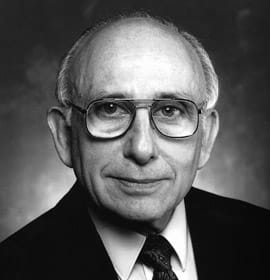Norman Joseph Woodland

- Bolstered by Research Consortium with Drexel, Jefferson’s Sidney Kimmel Cancer Center Earns NCI Comprehensive Cancer Center Designation
- No link between acetaminophen use during pregnancy and children's autism risk
- Drexel Recognizes Gregory E. Deavens, CPA, CGMA as Business Leader of the Year
- Through Connections and Community, Drexel Course Helps Launch Computer Lab in Tanzania

Norman Joseph Woodland, a 1947 graduate, who, along with classmate Bernard Silver, created the system for instant electronic recall of product information commonly called the barcode, passed away at the age of 91 on Dec. 9, 2012. The pair’s invention revolutionized the retail industry and is an example of a technology that has stood the test of time.
“We lost a great inventor and a contributor to the world of engineering,” Dr. Joseph Hughes, dean of Drexel University’s College of Engineering said. “Mr. Woodland was role model and an inspiration for our students. We are greatly saddened by this loss and our condolences are with the Woodland family at this time.”
Woodland graduated from Drexel Institute of Technology with a degree in mechanical engineering and continued his post-graduate studies at the school. In 1948, the head of a local grocery store chain came to Drexel in hopes of tapping the institution’s engineering school to develop a way to read product data during the checkout process. When the dean of the school turned down the offer, Silver and Woodland seized the opportunity.
At the time, card reading equipment that was used in stores was bulky and expensive. Woodland’s early inspirations for the barcode came from Morse code – a system of dots and dashes used to send coded messages via the telegraph, which he had learned when he was a Boy Scout.
While he was staying with his grandparents in Miami in the winter of 1948, Woodland’s moment of clarity struck as he sat on the beach drawing with his fingers in the sand.
“I just extended the dots and dashes downwards and made narrow lines and wide lines out of them,” Woodland said in a Wonders of Modern Technology article.
To read the codes, Woodland came up with a way of shining light through the lines to a light sensitive tube on the other side that converted the varying brightness of the light coming through the paper into electric waves that could be process to deliver information. Silver crafted the original coding pattern, which was in the form of a bull’s eye – so that it could be scanned in any direction. The engineers received a patent for their invention, called “Classifying Apparatus and Method,” on Oct. 7, 1952.
Woodland went on to work at I.B.M., from 1952 to 1987, where he helped to further develop the system as laser scanning technology and computer microprocessors became more prevalent and allowed the bar code to be widely used.
The barcode was first used in grocery stores in 1966 and saw widespread use after the Universal Grocery Products Identification Code was created in 1970 to standardize common grocery items. Today the system is used around the world and has also become important to the medical field where it is used to retrieve patient information.
Woodland received the National Medal of Technology and Innovation in 1992 and in 2011 he and Silver were inducted into the National Inventors Hall of Fame. On Oct. 22, 2012 the Institute of Electrical and Electronics Engineers officially dubbed Drexel “The Birthplace of the Barcode,” and the university unveiled an IEEE Milestone plaque in its College of Engineering to commemorate the achievement of Woodland and Silver.
In This Article
Contact
Drexel News is produced by
University Marketing and Communications.